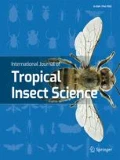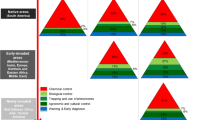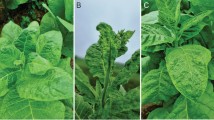Abstract
Whitefly is an important pest and vector of many plant begomoviruses. Investigations were carried out to understand the acquisition, retention, transmission, and gender basis transmission efficiency of Mesta yellow vein mosaic virus (MeYVMV) by whitefly. The minimum acquisition access feeding period (AAFP) was 0.10 h which resulted in 11.1% infected plants. Based on LAMP assay and yellowing symptoms, 100% virus acquisition was achieved by whitefly with an exposure of 18 to 48 h. Virus was transmitted in tested plants up to 88.8% after 1 to 10 days retention time of viruliferous whiteflies, whereas no symptoms were observed after 35 days. Fifteen minutes of exposure to viruliferous whiteflies on healthy plants resulted in 11.1% transmission. Cent percent transmission of virus was achieved in plants with 12 h exposure period. Highest virus transmission efficiency of 55.60% was observed in female whitefly compared to 33.3% in single male whitefly. Present study shall help to understand the interaction of insect-plant–virus relationship, epidemiological knowledge, and formulation of management strategies against virus and its vector.

Similar content being viewed by others
References
Boulehya S, Najar A, Sghairi R, Jarraya A (1997) Whitefly report of Tunisia. In: Ioannou N (Ed) Management of the whitefly-virus complex. Proceedings of the FAO workshop on management of the whitefly-virus complex in vegetable and cotton production in the Near East, 2-6 October, 1995, Larnaca, Cyprus. FAO, Rome, pp. 71–75
Caciagli P, Bosco D (1997) Quantitation over time of tomato yellow leaf curl geminivirus DNA in its whitefly vector. Phytopathol 87:610–613
Capoor SP, Ahmad RU (1975) Yellow vein mosaic disease of field pumpkin and its relationship with the vector, Bemisia tabaci. Indian Phytopathol 28:241–246
Chatterjee A, Ghosh SK (2007a) A new monopartite begomovirus isolated from Hibiscus cannabinus L. in India. Arch Virol 152:2113–2118
Chatterjee A, Ghosh SK (2007b) Association of a satellite DNA b molecule with Mesta yellow vein mosaic disease. Virus Genes 35:835–844
Chatterjee A, Roy A, Ghosh SK (2006) Yellow vein mosaic disease of kenaf. In: Roa GP, Khurana SMP, Lenardon SL (eds) ‘Characterization, diagnosis and management of plant viruses, Vol. 1: Industrial crops’. Studium Press, Houston, pp 497–505
Chatterjee A, Roy A, Padmalatha KV, Malathi VG, Ghosh SK (2005a) Yellow vein mosaic disease of Kenaf (Hibiscus cannabinus) and Roselle (H. sabdariffa) - a new disease in India caused by a Begomovirus. Indian J. Virol 16:55–56
Chatterjee A, Roy A, Padmalatha KV, Malathi VG, Ghosh SK (2005b) Occurrence of a Begomovirus with yellow vein mosaic disease of mesta (Hibiscus cannabinus and Hibiscus sabdariffa). Australas Plant Path 34:609–610
Chatterjee A, Sinha SK, Roy A, Sengupta DN, Ghosh SK (2007) Development of diagnostics for DNA a and DNA b of a begomovirus associated with mesta yellow vein mosaic disease and detection of geminiviruses in mesta (Hibiscus cannabinus L. and H. sabdariffa L.) and some other plant species. J Phytopathol 155:683–689. https://doi.org/10.1111/j.1439-0434.2007.01296.x
Chatterjee A, Roy A, Ghosh SK (2008) Acquisition, transmission and host range of a begomovirus associated with yellow vein mosaic disease of mesta (Hibiscus cannabinus and Hibiscus sabdariffa). Australas Plant Path 37:511–519
Cohen S, Nitzany FE (1966) Transmission and host range of the Tomato yellow leaf curl virus. Phytopathology 56:1127–1131
Czosnek H, Ghanim M, Morin S, Rubinstein G, Fridman V, Zeidan M (2001) Whiteflies: vectors, and victims (?), of geminiviruses. Adv Virus Res 56:291–322
Das S, Roy A, Ghosh R, Paul S, Acharyya S, Ghosh SK (2008) Sequence variability and phylogenetic relationship of betasatellite isolates associated with yellow vein mosaic disease of mesta in India. Virus Genes 37:414–424
Dhanju K, Dhillon GS, Singh M (1993) Reaction of French bean varieties (bush type) against Bean yellow mosaic virus. Indian J Virol 9:143–146
Doyle JJ, Doyle JL (1987) A rapid DNA isolation procedure for small quantities of fresh leaf tissue. Phytochemical Bulletin 19:11–15
Duke JA (1986) Isthmian ethnobotanical dictionary. (scientific Publisher: Jodhpur, India)
Fukuta S, Kato S, Yoshida K, Mizukami Y, Ishida A, Ueda J, Kanbe M, Ishimoto Y (2003) Detection of Tomato yellow leaf curl virus by loop-mediated isothermal amplification reaction. J Virol Methods 112:35–40
Garrett KA, Dendy SP, Frank EE, Rouse MN, Travers SE (2006) Climate change effects on plant disease: genomes and ecosystems. Annu Rev Phytopathol 44:489–509
Gerling D (2002) Whiteflies revisited. Manejo Integrado de Plagas 63:13–21
Ghosh R, Paul S, Roy A, Mir JI, Ghosh SK, Srivastava RK, Yadav US (2007) Occurrence of begomovirus associated with yellow vein mosaic disease of kenaf (Hibiscus cannabinus) in North India. Plant Health, Prog 8:21. https://doi.org/10.1094/PHP-2007-0508-01
Gibbs A, Harrison BD (1976) Physical and chemical methods of assay and analysis. Plant Virol John Wiley and Sons, New York
Greathead AH (1986) Host plants. In: Cock MJW (ed) Bemisia tabaci – a literature survey on the cotton whitefly with an annotated bibliography. CAB, Ascot, UK, pp 17–25
Jayashree K, Pun KB, Doraiswamy S (1999) Virus-vector relationship of Yellow vein mosaic virus and whitefly (Bemisia tabaci) in pumpkin. Indian Phytopathol 52:10–13
Jiang YX, DeBlas C, Barrios L, Fereres AD (2000) Correlation between whitefly (Homoptera: Aleyrodidae) feeding behavior and transmission of Tomato yellow leaf curl virus. Ann Entomol Soci America 93:573–579
Jiu M, Zhou XP, Liu SS (2006) Acquisition and transmission of two begomoviruses by the B and a non-B biotype of Bemisia tabaci from Zhejiang, China. J Phytopathol 154:587–591. https://doi.org/10.1111/j.1439-0434.2006.01151.x
Jones DR (2003) Plant viruses transmitted by whiteflies. Eur J Plant Pathol 109:195–219
Liu TX (2007) Life history of Eretmocerus melanoscutus (Hymenoptera: Aphelinidae) parasitizing nymphs of Bemisia tabaci biotype B (Homoptera: Aleyrodidae). Biol Control 42:77–85
Mahadevan N, Shivali, Kamboj P (2009) Hibiscus sabdariffa Linn. An overview. Natural Product Radiance 8:77–83
Martin JH, Mifsud D, Rapisarda C (2000) The whiteflies (Hemiptera: Aleyrodidae) of Europe and Mediterranean Basin. Bull. Entomol Res 90:407–448
Meena PN, Roy A, Gotyal BS, Mitra S, Satpathy S (2014a) Eco-friendly management of major diseases in jute (Corchorus olitorius L). J App and Nat Sci 2:541–544
Meena PN, Tripathi AN, Gotyal BS, Satpathy S (2014b) Bio-efficacy of phytoextracts and oil cakes on Macrophomina phaseolina (Tassi) causing stem rot disease of jute, Corchorus spp. J App and Nat Sci 2:530–533
Meena PN, Kharbikar L, Rana R, Satpathy S, Shanware A, Sivalingam PN, Nandanwar S (2019) Detection of Mesta yellow vein mosaic virus (MeYVMV) in field samples by a loop-mediated isothermal amplification reaction. J Virol Methods 263:81–87
Mehta P, Jeffrey AW, Nakhla MK, Douglas PM (1994) Transmission of Tomato yellow leaf curl geminivirus by Bemisia tabaci (Homoptera: Aleyrodidae). J Eco Entomol 87:1291–1297
Muniyappa V, Venkatesh HM, Ramappa HK, Kulkarni RS, Zeidan M, Tarba CY, Ghanim M, Czosnek H (2000) Tomato leaf curl virus from Bangalore (ToLCV-Ban4): sequence comparison with Indian ToLCV isolates, detection in plants and insects, and vector relationships. Arch Virol 145:1583–1598
Naranjo SE, Ellsworth PC (2009) The contribution of conservation biological control to integrated pest control of Bemisia tabaci in cotton. Biol Control 51:458–470
Narula AM, Monga D, Chauhan MS, Raj S (1999) Cotton leaf curl disease in India the challenge ahead. J Cotton Res and Develop 13:129–138
Nene YL (1973) Note on a fungus parasite of Bemisia tabaci Genn; a vector of several plant viruses. Indian J Agri Sci 43:514–516
Noor A, Hidayat SH, Suseno R, Sosromarsono S (2002) Transmission of an Indonesian isolates of Tomato leaf curl virus (Gemini virus) by Bemisia tabaci Genn. (Hemiptera: Aleyrodidae). Plant Pathol J 18:231–236
Oliveira MRV, Henneberry TJ, Anderson P (2001) History, current status, and collaborative research projects for Bemisia tabaci. Crop Prot 20:709–723
Pal DC and Jain SK (1998) ‘Tribal medicine.’ (Naya Prakash: Calcutta, India)
Paul S, Ghosh R, Roy A, Mir JI, Ghosh SK (2006) Occurrence of a DNA ß -containing begomovirus associated with leaf curl disease of kenaf (Hibiscus cannabinus L.) in India. Aus Plant Dis Notes 1:29–30
Pollard DG (1955) Feeding habits of the cotton whitefly, Bemisia tabaci Geen. (Homoptera: Aleyrodidae). Ann App Biol 43:664
Polston JE, Al-Musa A, Perring TM, Dodds JA (1990) Association of the nucleic acid of Squash leaf curl geminivirus with the whitefly Bemisia tabaci. Phytopathology 80:850–856
Rashid MH, Hossain I, Alam MS, Zaman MM, Hannan A (2008) Study on virus-vector relationship in TYLCV of tomato. Int J Sust Crop Prod 3:1–6
Roy A, De RK, Ghosh SK (2008) Diseases of bast fiber crops and their management in jute and allied fibers, pp.327. In: Karmakar PG, Hazara SK, Subramanian TR, Mandal RK, Sinha MK, Sen HS (eds) Updates production technology, ICAR-central research Institute for Jute and Allied Fibers. Barrckpore, West Bengal, India
Roy A, Acharya S, Das S, Ghosh R, Paul S, Srivastava RK, Ghosh SK (2009) Distribution, epidemiology and molecular variability of the begomovirus complexes associated with yellow vein mosaic disease of mesta in India. Virus Res 141:237–246
Rubinstein G, Czosnek H (1997) Long-term association of Tomato yellow leaf curl virus (TYLCV) with its whitefly vector Bemisia tabaci: effect on the insect transmission capacity, longevity and fecundity. J Gen Virol 78:2683–2689
Secker AE, Bedford ID, Markham PG, de Courcy-Williams ME (1998) Squash, a reliable field indicator for the presence of the B biotype tobacco whitefly, Bemisia tabaci. British Crop Prot Council, Brighton Conf 3:837–842
Seetharama RK, Yaraguntaiah RC (1981) Virus vector relationship in leaf curl disease of tomato. Indian Phytopathol 34:310–313
Simmons AM, Harrison HF, Ling KS (2008) Forty-nine new host plant species for Bemisia tabaci (Hemiptera: Aleyrodidae). Entomol Sci 11:385–390
Varma PM (1952) Studies on the relationship of the Bhendi yellow vein mosaic virus and its vector, the whitefly, Bemisia tabaci Genn. Indian J Agri Sci 22:75–91
Wan FH, Zhang GF, Liu SS, Luo C, Chu D (2009) Invasive mechanism and management strategy of Bemisia tabaci (Gennadius) biotype B: Progress report of 973 program on invasive alien species in China. Sci China C Life Sci 52:88–95
Wong YH, Tan WY, Tan CP, Long K, Nyam KL (2014) Cytotoxic activity of kenaf (Hibiscus cannabinus L.) seed extract and oil against human cancer cell lines. Asian Pac J Trop Biomed 4(1):510–515
Zhang GF, Lü ZC, Wan FH (2007) Detection of Bemisia tabaci (Homoptera: Aleyrodidae) remains in predator guts using a sequence-characterized amplified region marker. Entomol Exp Appl 123:81–90
Acknowledgments
The author is grateful to the Director and Head, Crop Protection Division, ICAR-Central Research Institute for Jute and Allied Fibers, Barrackpore, Kolkata, for providing support to undertake the study.
Author information
Authors and Affiliations
Corresponding author
Ethics declarations
Conflict of interest
They have no conflict of interest.
Additional information
Publisher’s note
Springer Nature remains neutral with regard to jurisdictional claims in published maps and institutional affiliations.
Rights and permissions
About this article
Cite this article
Meena, P.N., Gotyal, B.S. & Satpathy, S. Mesta yellow vein mosaic virus: application of loop-mediated isothermal amplification method to study efficiency of acquisition, retention and transmission by Bemisia tabaci (Hemiptera: Aleyrodidae) in Kenaf. Int J Trop Insect Sci 41, 1277–1284 (2021). https://doi.org/10.1007/s42690-020-00319-0
Received:
Accepted:
Published:
Issue Date:
DOI: https://doi.org/10.1007/s42690-020-00319-0




